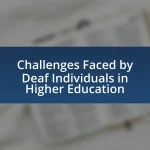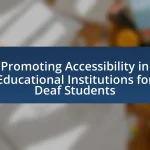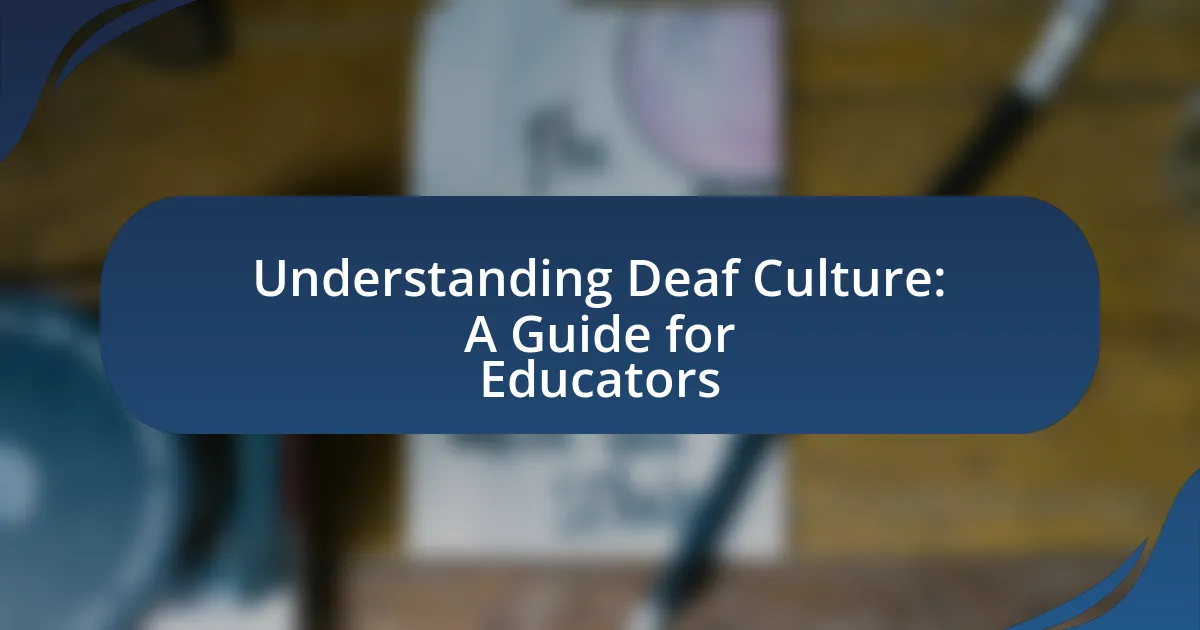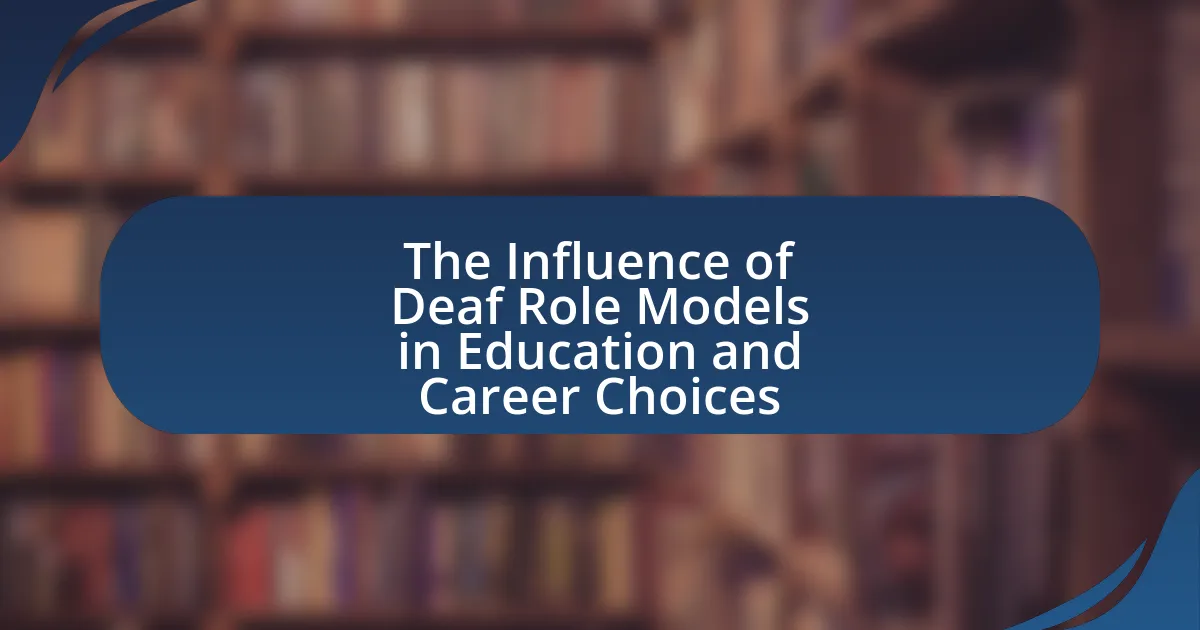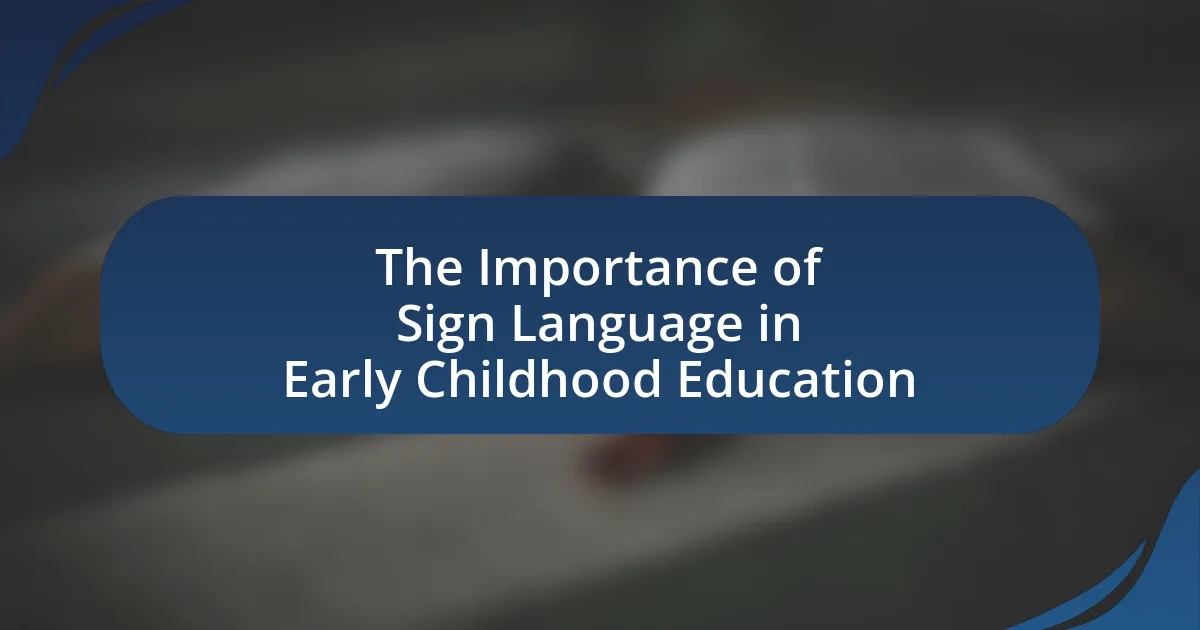Effective communication techniques for teaching deaf students are essential for enhancing their learning experiences and academic performance. Key strategies include the use of sign language, visual aids, and clear facial expressions, which cater to the unique communication needs of deaf learners. The article explores how these techniques differ from traditional teaching methods, the principles of effective communication, and the impact of understanding deaf culture on teaching practices. Additionally, it addresses the importance of creating an inclusive environment, assessing communication effectiveness, and overcoming common challenges faced in the classroom. By implementing these strategies, educators can significantly improve engagement and comprehension among deaf students.
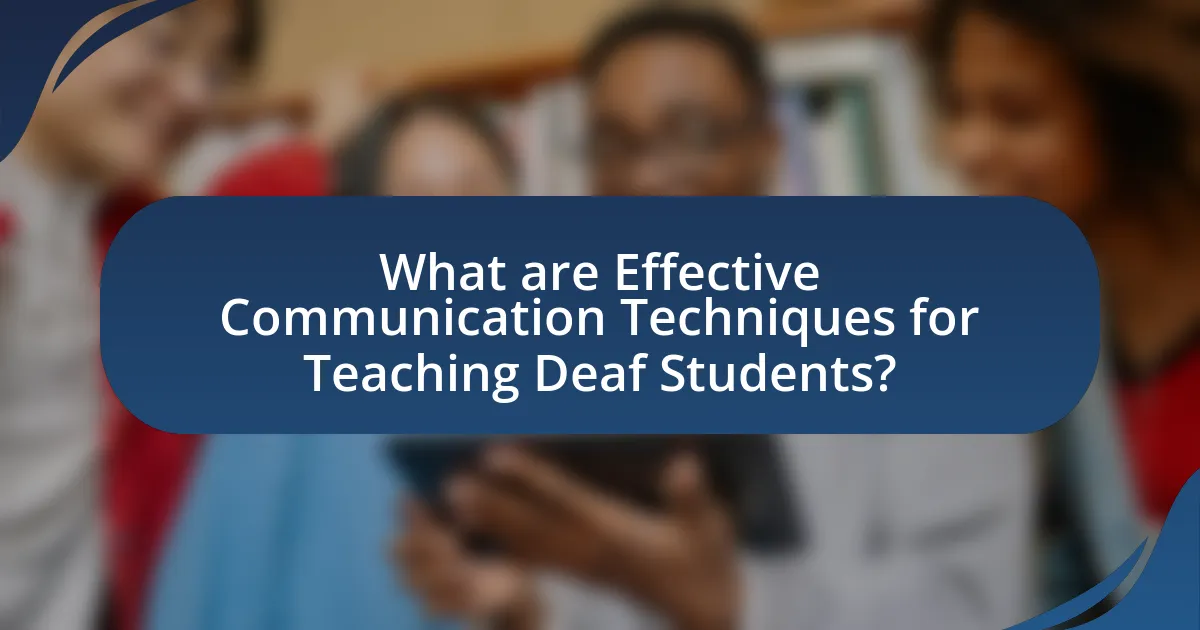
What are Effective Communication Techniques for Teaching Deaf Students?
Effective communication techniques for teaching deaf students include the use of sign language, visual aids, and clear facial expressions. Sign language serves as a primary mode of communication, allowing deaf students to understand and engage with the material effectively. Visual aids, such as charts, videos, and illustrations, enhance comprehension by providing context and supporting information. Additionally, clear facial expressions and body language are crucial, as they convey emotions and emphasize key points, making the learning experience more interactive and accessible. Research indicates that these techniques significantly improve learning outcomes for deaf students by fostering better understanding and retention of information.
How do these techniques differ from traditional teaching methods?
Effective communication techniques for teaching deaf students differ from traditional teaching methods primarily in their emphasis on visual and tactile learning modalities. Traditional methods often rely heavily on auditory instruction, which is ineffective for deaf students. In contrast, effective techniques incorporate sign language, visual aids, and hands-on activities to facilitate understanding. Research indicates that using visual communication strategies significantly enhances learning outcomes for deaf students, as evidenced by studies showing improved comprehension and retention rates when visual methods are employed.
What are the key principles of effective communication for deaf students?
The key principles of effective communication for deaf students include the use of clear visual cues, the incorporation of sign language, and ensuring an inclusive environment. Clear visual cues, such as gestures and facial expressions, enhance understanding by providing context and emphasis. Incorporating sign language as a primary mode of communication allows deaf students to access information in a way that is natural and intuitive for them. Creating an inclusive environment involves fostering a culture of respect and awareness among hearing peers, which facilitates better interactions and reduces communication barriers. Research indicates that these principles significantly improve engagement and learning outcomes for deaf students, as evidenced by studies showing higher academic performance in environments that prioritize visual communication methods.
How does understanding deaf culture influence teaching methods?
Understanding deaf culture significantly influences teaching methods by promoting culturally responsive pedagogy that respects and incorporates the values, communication styles, and experiences of deaf students. This understanding leads educators to adopt visual teaching strategies, such as the use of sign language, visual aids, and interactive activities, which align with the visual learning preferences prevalent in deaf culture. Research indicates that when teachers are aware of the cultural context of their students, they can create a more inclusive and supportive learning environment, ultimately enhancing student engagement and academic success. For instance, studies show that deaf students perform better academically when their teachers integrate aspects of deaf culture into the curriculum, fostering a sense of belonging and identity.
Why is effective communication crucial for deaf students’ learning?
Effective communication is crucial for deaf students’ learning because it directly impacts their ability to access information and engage with educational content. Deaf students rely on visual communication methods, such as sign language and written text, to understand lessons and participate in discussions. Research indicates that when teachers employ effective communication strategies tailored to deaf students, such as using clear visual aids and sign language interpretation, students demonstrate improved comprehension and academic performance. For instance, a study published in the Journal of Deaf Studies and Deaf Education found that deaf students who received instruction through sign language showed significantly higher achievement in literacy compared to those who did not. This evidence underscores the necessity of effective communication in fostering an inclusive and supportive learning environment for deaf students.
What impact does communication have on academic performance?
Effective communication significantly enhances academic performance. Clear communication fosters understanding, engagement, and collaboration among students and teachers, which is crucial for learning, especially for deaf students who rely on visual cues and sign language. Research indicates that effective communication strategies, such as the use of visual aids and interactive teaching methods, lead to improved comprehension and retention of information. For instance, a study published in the “Journal of Deaf Studies and Deaf Education” by Marschark et al. (2015) found that deaf students who received instruction through effective communication techniques performed better academically compared to those who did not. This demonstrates that the quality of communication directly influences educational outcomes.
How does effective communication foster social interaction among deaf students?
Effective communication fosters social interaction among deaf students by enabling them to share ideas, emotions, and experiences in a way that is accessible and meaningful. When deaf students use sign language or other effective communication methods, they can engage in conversations, build friendships, and participate in group activities, which are essential for social development. Research indicates that environments promoting effective communication, such as inclusive classrooms, lead to increased social engagement and collaboration among deaf students, enhancing their overall educational experience and social skills.

What specific strategies can be employed for effective communication?
Effective communication strategies for teaching deaf students include the use of visual aids, sign language, and interactive teaching methods. Visual aids, such as charts and images, enhance understanding by providing context and clarity. Sign language serves as a primary mode of communication, allowing students to express themselves and comprehend lessons effectively. Interactive teaching methods, including group activities and hands-on learning, foster engagement and facilitate peer communication. Research indicates that these strategies significantly improve learning outcomes for deaf students, as they cater to their unique communication needs and learning styles.
How can visual aids enhance communication in the classroom?
Visual aids enhance communication in the classroom by providing visual representations of information, which can significantly improve understanding for students, particularly those who are deaf. Research indicates that visual aids, such as charts, diagrams, and videos, facilitate better retention of information and support diverse learning styles. For instance, a study published in the “Journal of Deaf Studies and Deaf Education” found that students who utilized visual aids scored higher on comprehension tests compared to those who did not. This demonstrates that visual aids not only clarify complex concepts but also engage students more effectively, making learning more accessible and inclusive.
What types of visual aids are most effective for deaf students?
Visual aids that are most effective for deaf students include images, diagrams, videos with captions, and sign language animations. These aids enhance comprehension by providing visual representations of concepts, which is crucial for students who rely on visual learning. Research indicates that the use of multimedia resources, such as videos with sign language interpretation, significantly improves understanding and retention of information among deaf learners. For instance, a study published in the Journal of Deaf Studies and Deaf Education found that students who engaged with captioned videos performed better in comprehension tests compared to those who did not use such resources.
How can technology be integrated into teaching strategies?
Technology can be integrated into teaching strategies by utilizing tools such as interactive software, digital communication platforms, and assistive devices tailored for deaf students. These technologies enhance engagement and facilitate understanding through visual aids, real-time captioning, and sign language applications. For instance, research indicates that the use of video conferencing tools allows for effective sign language instruction, enabling students to interact with teachers and peers in real-time, thus improving their communication skills. Additionally, the implementation of educational apps designed for deaf learners has been shown to increase vocabulary acquisition and comprehension, as evidenced by studies conducted by the National Technical Institute for the Deaf, which highlight the positive impact of technology on learning outcomes for deaf students.
What role does sign language play in effective communication?
Sign language plays a crucial role in effective communication, particularly for individuals who are deaf or hard of hearing. It serves as a primary mode of expression and comprehension, enabling users to convey thoughts, emotions, and information visually through gestures, facial expressions, and body language. Research indicates that sign language enhances cognitive processing and social interaction among deaf individuals, fostering a sense of community and belonging. For instance, studies show that deaf students who use sign language perform better academically and socially compared to those who rely solely on spoken language. This underscores the importance of incorporating sign language into educational settings to facilitate meaningful communication and learning experiences for deaf students.
How can teachers become proficient in sign language?
Teachers can become proficient in sign language by engaging in formal education programs, attending workshops, and practicing regularly with fluent sign language users. Formal education programs, such as those offered by universities or community colleges, provide structured learning and certification opportunities, which are essential for developing a strong foundation in sign language. Workshops often focus on specific skills or contexts, allowing teachers to enhance their vocabulary and understanding of cultural nuances. Regular practice with fluent sign language users, including deaf individuals, reinforces learning and improves fluency through real-life application. Research indicates that immersive experiences significantly enhance language acquisition, making consistent interaction with the deaf community a critical component of proficiency.
What are the benefits of using sign language in the classroom?
Using sign language in the classroom enhances communication for deaf students, facilitating better understanding and engagement. Research indicates that incorporating sign language improves language acquisition and cognitive development, as it provides a visual and spatial mode of communication that aligns with the learning styles of many deaf students. A study published in the Journal of Deaf Studies and Deaf Education found that students who used sign language demonstrated higher levels of academic achievement compared to those who did not. Additionally, sign language fosters social interaction and inclusion, creating a more supportive learning environment.
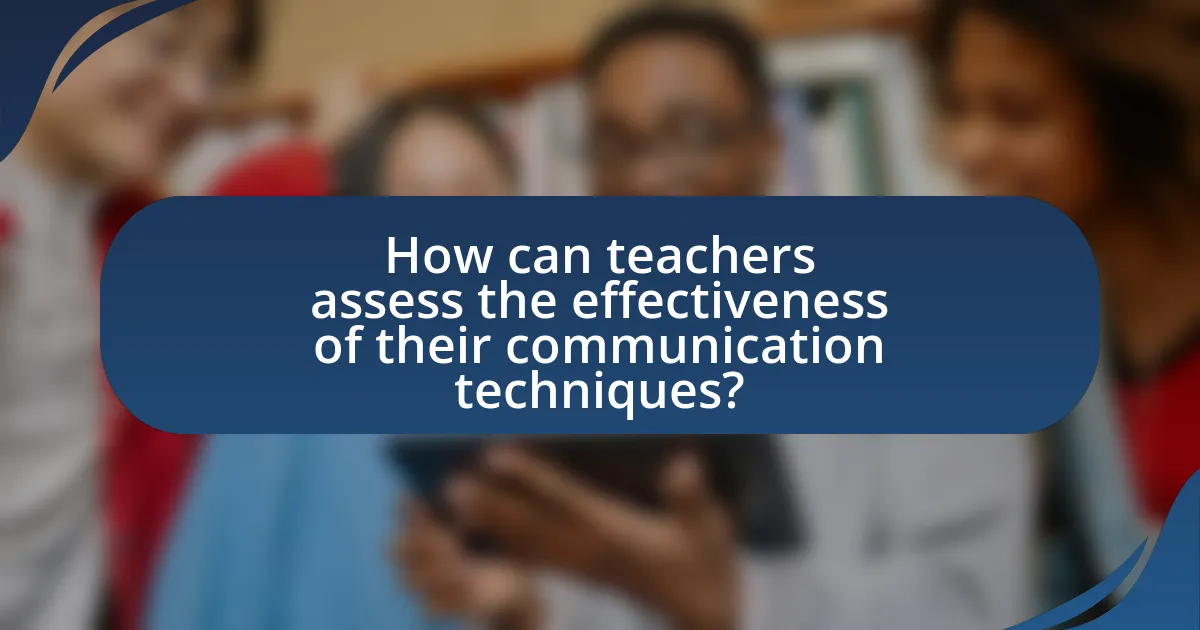
How can teachers assess the effectiveness of their communication techniques?
Teachers can assess the effectiveness of their communication techniques by utilizing feedback mechanisms, observational assessments, and student performance metrics. Feedback mechanisms, such as surveys or interviews with students, provide direct insights into how well students understand the material and the clarity of the communication. Observational assessments involve teachers reflecting on their interactions during lessons, noting areas where students appear engaged or confused. Additionally, analyzing student performance metrics, such as test scores and participation rates, can indicate whether communication strategies are facilitating learning. Research indicates that effective communication is linked to improved academic outcomes, particularly in specialized contexts like teaching deaf students, where clarity and engagement are crucial for comprehension.
What methods can be used to evaluate student understanding?
Methods to evaluate student understanding include formative assessments, summative assessments, observations, and self-assessments. Formative assessments, such as quizzes and class discussions, provide ongoing feedback during the learning process, allowing educators to adjust instruction as needed. Summative assessments, like final exams or projects, measure student learning at the end of an instructional period. Observations involve monitoring student engagement and participation in class activities, which can indicate comprehension levels. Self-assessments encourage students to reflect on their own understanding and learning progress. Research indicates that using a combination of these methods leads to a more comprehensive evaluation of student understanding, as supported by studies in educational psychology that emphasize the importance of varied assessment strategies for effective learning outcomes.
How can feedback from students inform teaching practices?
Feedback from students can significantly inform teaching practices by providing insights into their understanding and engagement levels. When students share their experiences and perceptions, educators can identify areas where instructional methods may need adjustment, such as pacing, clarity, or the effectiveness of communication techniques. For instance, research indicates that student feedback can lead to improved academic performance, as it allows teachers to tailor their approaches to meet diverse learning needs. A study published in the “Journal of Educational Psychology” by Hattie and Timperley (2007) emphasizes that feedback is a critical component of the learning process, enabling educators to refine their strategies based on direct input from learners. This iterative process enhances the overall educational experience, particularly in specialized contexts like teaching deaf students, where effective communication is paramount.
What tools are available for assessing communication effectiveness?
Tools available for assessing communication effectiveness include surveys, observation checklists, and communication assessments. Surveys can gather feedback from students and teachers regarding their perceptions of communication clarity and effectiveness. Observation checklists allow educators to systematically evaluate communication strategies in real-time, noting areas of strength and improvement. Communication assessments, such as standardized tests or informal assessments, measure students’ understanding and use of language, providing quantitative data on communication skills. These tools are essential for identifying gaps in communication and enhancing teaching strategies for deaf students.
What are some common challenges faced in communicating with deaf students?
Common challenges faced in communicating with deaf students include barriers in language comprehension, limited access to auditory information, and varying levels of sign language proficiency. Language comprehension issues arise because many deaf students may not fully grasp spoken language, leading to misunderstandings. Limited access to auditory information means that these students miss out on verbal cues and nuances that hearing students receive, which can hinder their engagement and learning. Additionally, varying levels of sign language proficiency among students can create disparities in communication effectiveness, as some may be fluent while others may struggle with basic signs. These challenges necessitate tailored communication strategies to ensure effective learning environments for deaf students.
How can teachers overcome barriers to effective communication?
Teachers can overcome barriers to effective communication by employing visual aids, sign language, and technology to enhance understanding. Utilizing visual aids such as charts, diagrams, and videos caters to the visual learning preferences of deaf students, making complex information more accessible. Incorporating sign language as a primary mode of communication fosters direct interaction and reduces misunderstandings. Additionally, leveraging technology, such as captioning services and speech-to-text applications, can bridge communication gaps, ensuring that all students receive the same information simultaneously. Research indicates that these strategies significantly improve engagement and comprehension among deaf students, as evidenced by studies showing enhanced academic performance when visual and technological supports are integrated into teaching practices.
What strategies can be implemented to address diverse needs among deaf students?
To address diverse needs among deaf students, educators can implement individualized education plans (IEPs) tailored to each student’s unique communication preferences and learning styles. IEPs ensure that specific accommodations, such as sign language interpreters, visual aids, and assistive technology, are provided to enhance learning. Research indicates that personalized approaches significantly improve academic outcomes for deaf students, as evidenced by a study published in the Journal of Deaf Studies and Deaf Education, which found that students with tailored support demonstrated higher engagement and achievement levels.
What best practices can enhance communication with deaf students?
To enhance communication with deaf students, educators should utilize visual aids, sign language, and clear facial expressions. Visual aids, such as charts and images, support comprehension by providing context and reinforcing verbal information. Sign language is essential for direct communication, as it allows deaf students to engage fully in discussions and understand concepts clearly. Additionally, using clear facial expressions and body language helps convey emotions and nuances that may not be captured through words alone. Research indicates that incorporating these practices significantly improves engagement and learning outcomes for deaf students, as evidenced by studies showing higher retention rates and participation levels when visual and signed communication methods are employed.
How can teachers create an inclusive classroom environment?
Teachers can create an inclusive classroom environment by implementing differentiated instruction and fostering a supportive atmosphere. Differentiated instruction allows teachers to tailor their teaching methods to accommodate diverse learning needs, ensuring that all students, including those who are deaf, can access the curriculum effectively. Research indicates that using multiple modes of communication, such as visual aids, sign language, and technology, enhances understanding and engagement for deaf students (Marschark & Hauser, 2012). Additionally, fostering a supportive atmosphere involves promoting respect, collaboration, and open communication among students, which has been shown to improve social interactions and learning outcomes in inclusive settings (Friend & Cook, 2013).
What ongoing professional development opportunities are available for teachers?
Ongoing professional development opportunities for teachers include workshops, online courses, and conferences focused on effective communication techniques for teaching deaf students. These programs often provide educators with the latest research, strategies, and resources to enhance their teaching practices. For instance, organizations like the National Association of the Deaf offer specialized training sessions that address the unique needs of deaf learners, ensuring teachers are equipped with effective instructional methods. Additionally, universities and educational institutions frequently host webinars and certification programs that focus on inclusive education and communication strategies, further supporting teachers in their professional growth.

